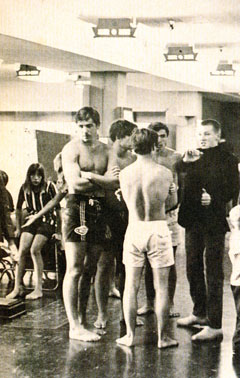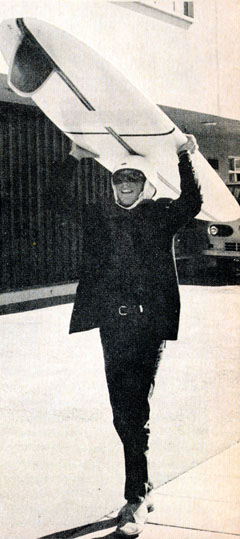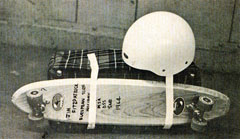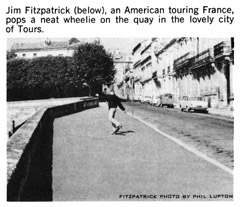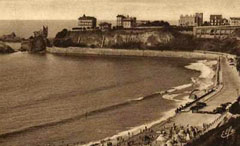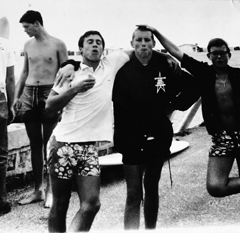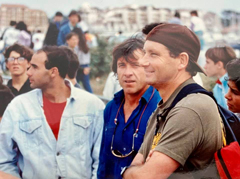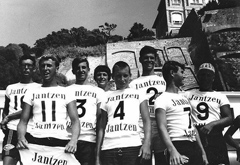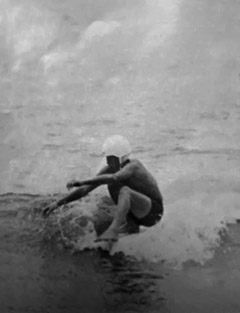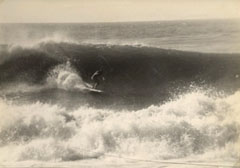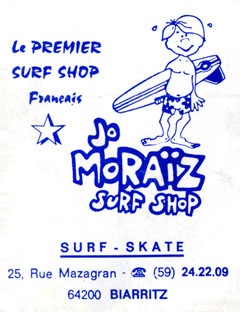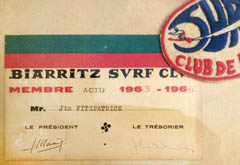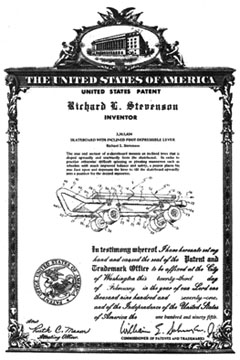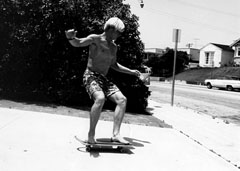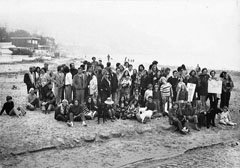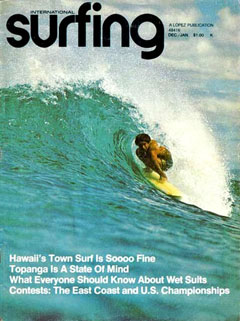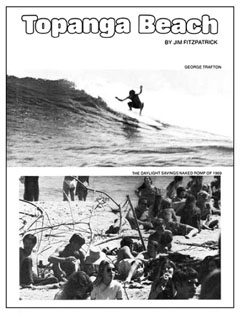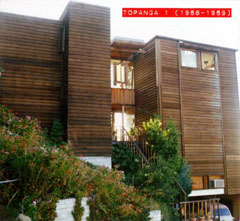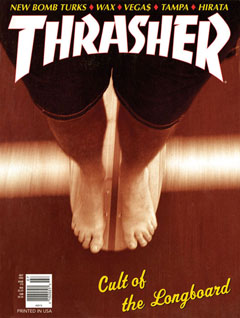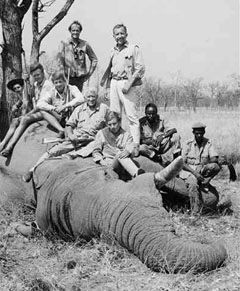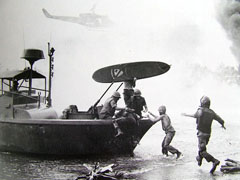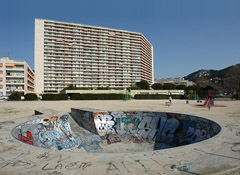| |
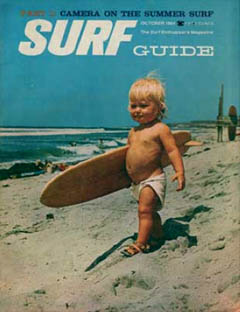 |
|
Jim Fitzpatrick :
exclusive interview 2011
CONTINUED FROM PART
1
ESH : European Surfing Holiday
In July 1964, your story will cross ours as you depart for Europe. Tell us the idea for this trip launched by the magazine "Surfer Magazine's Guide"?
It was for what purpose?
“Surf Guide”’s editor, Bill Cleary, had been to Europe and Morocco in 1963. He also went to the Canary Islands. He was a good writer looking to live like Ernest Hemingway in some far off location with lots of beautiful women around. He wasn’t far off the mark during that trip in 1963. He came back saying, “We all have to go to these places!”
One of his room-mates, Larry Krause, who at the time was a West Los Angeles lifeguard and worked at the Rand Corporation down the hall from Daniel Ellsberg, was looking for something to do that would allow him to make money and not work and hang around the beach with beautiful women.
He and Bill came up with the idea for starting a charter company to take surfers around the world on exotic surfing adventures. The first of these expeditions was “The European Surfing Holiday,” with two weeks in Biarritz and then 6 weeks on your own; those on the holiday could surf, stay in Biarritz, and then decide what else they wanted to do.
So, Surf Guide Magazine was involved by giving advertising and promotional space to the ESH project, and eventually they helped to discount my ticket, too. “Jimmy can go and take 12 skateboards with him, and he’ll skateboard wherever he goes!”
The only problem was that ESH was too far ahead of its time. Surfers weren’t ready to go to Europe, yet, and not enough of them were willing to spend the $400/RT for the airfare. A few days before the flight Larry realized he’d have to tell World Airways he didn’t have enough tickets sold, and their response was, “You can fly on the Super Constellation!”
And that’s what happened, we flew on a propeller plane to Paris. 30 hours? It was a nightmare, but we landed at CDG and I skateboarded from the plane to the terminal! Piston driven, the Super Constellation was the last of the great airliners before jet engines took over.
What was funny is that a few guys from Malibu found out there were available seats on the plane, and they ended up buying round trip tickets for $100—Larry was selling tickets at the airport to be that promised him they would have the money by the time the plane took off.
What is France for you?
France for me was ‘civilization.’ The language of diplomacy. Cleary was a big influence in my life, as was the ESH’s Larry Krause. Cleary was fluent in Spanish, and Krause in French, and they both loved Europe. It was part of their anti-American bohemian style rejection of the Ugly American. They didn’t want to be Americans in Europe, and so neither did I.
I just loved the whole experience, and I loved the French girls. Their attitude was so completely different and less pretentious than American girls…every time I’m in France I fall in love every moment, regardless of where I am.
I learned to appreciate ‘culture’ in France. Fine food. Simple, delicious food. Simple refined clothing. Everything was ‘better’ and easier and made sense to me.
Later, having gone to school in Italy, I’ve become more efficient in communication with Italian; but I’d still like to live in France. The geology of Biarritz is so similar to southern California, it’s stunning when you compare the beaches and the light. I felt at home when I traveled in France.
What idea did you have regarding surfing in France?
A guache! A droit! It was hysterical to announce which direction we were to go when taking off at Grande Plage. Very very funny. At the beach house was my first encounter with a “European” toilet…no seat, just the whole between the foot places! hahahahahaha
Are you the youngest surfer in that trip?
I think I was, yes.
I was 16.
Despite your young age, did you feel to have a pioneering role?
I think I did, yes, only because there were so many times on that trip that no one knew what I was doing…no one could figure out what I was doing, so it was more that I knew that it was unusual, and that made it special for me.
How is air travel?
The flight was awful. Terrible. Young passengers drank and got sick. People were drunk and vomiting, and the air conditioning went out and interior of the plane became very very hot. Worst flight of my life.
What is your feeling when you land in Paris for the first time?
I had this whole weird feeling about Charles Lindbergh; making it to France. I identified heavily with the Jimmy Stewart movie, “The Spirit of St. Louis.” We were on a piston driven airplane, we had propellers to look at out the window. “Were we going to make it?”
Getting off the plane was such a relief, and I skateboarded right toward the terminal until the Gendarmes ran in front of me yelling and screaming.
What strikes you most? Car size? Street? Dress?
The difference. EVERYTHING was different. I loved the difference.
How long do you stay in Paris?
Two days in Paris, we went to the Eiffel Tower and I skateboarded there. We stayed on the left bank and I tried to skate around there but the cobblestones…I remember being very frustrated at not finding places to skate around our little hotel on the left bank.
Where do you go to skate? Do you remember the reactions of people? Did they try?
I skated at the airport, outside the terminal; doing little tic-tac turns around in a circle, and maybe a handstand, and people assembled into a circle and clapped and murmured the whole time…when I stopped, and there must have been 150 people, they exploded into applause. It was amazing, I held my board over my head and they clapped louder. Had I stickers or some such, I could have made a big impact, but no stickers, nothing to toss, just their memories of what they saw!
Do you leave some skateboards to someone in Paris?
No, I took all my boards to Biarritz
Is it true that you are the first person ever to skate under the Eiffel Tower? Where you alone or with the De Rosnay brothers?
My second day in Paris we went to the tower and I skateboarded there for about an hour. At one point there must have 200 people in a circle watching me. Clapping. A great experience for me. I carried my skateboard to the top of the tower.
From Paris, how do you travel to Biarritz? Hitchike?
With whom do you do this trip?
My uncle was also one of the passengers on the European Surfing Holiday, and I rode with him in a VW Squareback that he had purchased and taken delivery of in Paris. In fact, he went to pick up his car, and I went to the Eiffel Tower, which is why I have no photographs of the historic event!
My surfboard went with the rest of the group on the train from Gare du Nord to Biarritz. There were about 50 surfboards in the luggage compartment!
How long does it takes for you to go to Biarritz?
We drove in two days to Biarritz.
What are your impressions when you go to Paris and you discover the landscape, smaller towns, villages ... Was France very different from the US?
I was studying painting in school, and the Impressionists made a huge impact upon me. It was as if I was stepping into Van Gogh’s paintings. I loved it.
I remember outside Tours there was a roadway closure, or repair, and the traffic was stopped in both directions on a hillside, and I got out of the car and started down the hill, a very long hill. Carving turns side to side on the smooth highway surface, very different from the cobblestone streets in Paris. The traffic was stopped for nearly an hour, and people got out of their cars with bread and cheese and wine and started picnicking along the road and they would cheer as I rode past. Then I’d walk back up the hill and do it again. Cheers!
What is the most unexpected reaction that caused you smile?
There was a formal greeting from the mayor for the whole Surfing Holiday group, with speeches and champagne and food, and when we left I have given one of the other surfers on the trip one of my skateboards and we skated out of the city hall building into the street and two gendarmes chased after us, so we kept going, and they started yelling and blowing whistles and before giving up the chase. I had no idea what they wanted or what they were yelling.
How do you meet the De Rosnay brothers?
They had met Bill Cleary the year before we arrived, and Bill had made sure to let them know I was part of the ESH group. At the time I didn’t know there were two surf clubs, that there was political tension between the two groups: Surf Club de France, and The Biarritz Surf Club. I didn’t know, at the time, I was young and Rosnay and Moraiz were always nice to me and very accommodating, but I don’t thing they were friendly to each other…the were rivals attempting to position themselves as THE surf expert for Biarritz.
What kind of friendship did you have with them?
I felt like I was friends with and befriended by everyone. It was a wonderful time, and I was welcomed into everyone’s lives and homes and businesses.
Biarritz
What is your feeling when you discover Biarritz and its waves?
I was young and didn’t realize how fantastic Biarritz was; that it had a casino, and was a playground for the wealthy and the sophisticated from across Europe. For me, then, it was a surf spot! I remember riding my clay-wheeled Makaha skateboard from the town to Grand Plage. Past the tower building there, and back along toward the beach.
It’s a beautiful place, and Hossegor and St. Jean de Luz—we surfed the break in the river at St. Jean de Luz, it’s still one of the great surfing experiences of my life. The waves were relatively small, but perfect right and left peaks; about head high, and I rode forever! My memory is that I was moving up the river as much as I was moving along the face of the wave; as if I was going forward but not sideways.
The Spanish guardia were on the breakwater; they had those black hats that were folded on one side so they could lean against a wall and not crush their hats? I remember telling people that if we go to close to the breakwater they lowered their machine guns, but I don’t know if that really happened.
The time of your stay in Biarritz, you participate in a surfing competition in which you finish 4th. You will find the group of surfers with whom you had made the trip from the United States?
Yeah, I think I won that contest! Hahahahahahaha
I recall the tide radically affected the surf, which was never too big during the whole time I was there. The day of the contest the surf was poor, but it was a great day and I remember I had white shirt with a numeral on it. I would have won had I caught better waves! hahaha !
In a photo, you' re surfing with a helmet on…
Ten days before our departure in Europe, I fell on the back of my head at Topanga, knocked myself unconscious and nearly drowned in two foot surf. Six stitches closed up the wound and Dody, my mom, declared, “That’s it ! You’re wearing a helmet from now on !” A dody decree. “You’ll kill yourself !” No way I said to myself. “And you’re taking it on your trip, too !” We trekked down to Grande Plage for a purpose, to get a photo of me surfing with the helmet on. The next day I gave the helmet to a cute girl riding a scooter, she didn’t really want it either, but price was right.
What do you think the level of local surfers at Biarritz? There weren’t very many, but I never paid much attention to the level, what I really enjoyed was that everyone in the water LOVED surfing. There was such genuine appreciation for us, les Americans, and I was so stoked to be there, and everyone on the ESH was stoked to be there, so we were just one happy group!
Do you have the same kind of reaction from the spectators who see you skate at Biarritz or are they less surprised?
You know, everyone in Biarritz is so sophisticated they’ve seen everything! Nothing surprises them! Hahahahaha
In fact, there were only a few streets where I could skate, and at Grande Plage I skated every day at the end of the road there, and I shared my board, and it was just fun to do. Everyone there wanted to try…and they were very appreciative of my ability.
Do you meet people that already know about skateboarding?
De Rosnay, Moraiz, they knew, but I don’t think anyone else had a skateboard.
How many boards do you sell/distribute in Biarritz?
I left one board with de Rosnay, and maybe one with Moraiz…
Do you try to sell/distribute Makaha skateboards to local retailers/distributors?
There weren’t any dealers or shops or retailers…there were the two clubs, and there was someone trying to make surfboards, but I don’t think he had a shop.
A year later, in August 1965, the first championships of France skate will take place in Hossegor. At that time, the French refer to the skateboard, known as "Roll-Surf". Was it a word you used or is that a typically French expression?
No, that wasn’t my expression…
Have you had time to develop relationships that have turned into friendships with people you've met on site (Biarritz, Paris…)?
Unfortunately, not really. Michel Lartigau? Francois Barland? Was Francois a Barland, a Lartigau or a Rosnay? I think it's François Lartigau!
“Francois le Grem” was my age, and he and I surfed together and skateboarded together, and he was a true companion…when I arrived in 1989 he was at the demo and worked for Quicksilver…it was the first time we’d seen each other in 25 years!
At the time of your departure, are there skaters who are beginning to master skateboarding?
Nope…Francois le Grem was doing well, and that’s why I think I left a board with him.…
Can you explain how you met Jo Moraiz? Did he have already a surf shop at the time or did he set-up his surf shop later on? Do you meet other surfers like Barland? Others?
Cleary’s visit had paved the way for my meeting so many of them. I still have my Biarritz Surf Club Membership card; it’s been on my wall every since 1964 (wherever my wall has been!). Jo and Rosnay were rivals? The whole political thing didn’t make sense to me…but Jo Moraiz had his surf shop in 1989 when we were there, and I believe he opened the shop right after the ESH left town, or maybe it was already open, but I don’t recall going to it in 64. Jo seemed very genuine to me, and he was very happy to greet me in 89.
When I worked at Powell Peralta Skateboards I directed the World Tours, but I coordinated the Euro trips with our distributors, not the retailers as in the states. So, the French Distributor was / is from Paris (I’ll remember his name in a minute) and he had coordinated our visit to Biarritz; I didn’t know where we were going or where the demo would be, none of the details. I had sent press packages to be distributed, so Jo knew I was going to be there, and he knew where the demo was and that Mike McGill, Steve Caballero, Marc Saito, and Tommy Guerrero were with me.
We were only in Biarritz two nights; arriving late one day, doing the demo the next day; being part of a huge party and then a smaller party; and then leaving town for Paris on the train the next day.
That first morning in Biarritz I was skateboarding around town on my Powell Peralta longboard, sort of recalling my whole clay-wheeled experience 25 years before, when I suddenly found myself in front of Jo’s surf shop. I was staring in the window when he opened the door and exclaimed, “Jimmy! It’s really you!” I always felt Jo was a real guy. Really into surfing and the lifestyle of surfing and skateboarding.
Do you still have contacts with Joel De Rosnay?
In Biarritz, in 64 was when I first contacted him, probably the first or second day we were there. I know that Joel was part of the organization of the mayor’s reception. This was a big deal for him, I think. And there were a few of us who didn’t give a dam because they were passing around trays of champagne and as a young teenager we just got silly drunk, and were probably obnoxious. No, no contacts now.
Did you meet with Jean Pierre Marquand at that time, or later (he was a manufacturer of skateboards in France –mid 70’s)?
No, I don’t think I ever met him.
ESH : European Skating Holiday
You continue your journey through Europe on the first visit to Spain. How did you find a country that lived at that time, under a military regime of terror ...
I remember the little hotels and hostels we stayed in were VERY strict about Passport control. The police with their machine guns were always very intimidating, but not so much in the country. We went to Toledo, I skateboarded there. No problem. Sangria!
But I skateboarded in Madrid and a policeman (guarda?) stopped me with a finger, he approached me and wagged his finger back and forth while holding his machine gun against his chest. I stopped.
Barcelona, no problem. Barcelona was like another country. Valencia, no problem.
You continue your journey in France along the Mediterranean coast. Do you remember having skated in Marseille for example?
Yes. Every time the car stopped I got out and skateboarded. I tried not to walk. The more we traveled the more I became obsessed with “skateboarding across Europe!”
Of all the countries visited, what is the one who has left the strongest impression of scenery?
That’s a tough question. I know this, I love Europe. I love traveling in Europe, I love being in Europe, I so admire the then and the now. The historical significance folded into present day life is something that still is so important to me. The Renaissance and Enlightenment periods are very important, and when I’m in Europe, especially France and Italy, I feel I’m living that experience.
My wife and I have been to Scotland twice over the past two years, Edinburgh and then to the north country; I skateboarded in Edinburgh in 64 right by the castle and down by the train station. It’s bizarre to be in places and realize, “Wait! I skated here 40 years ago!”
Skateboarding in 1964 was silly and no one could relate to it, and that was perfect for me because it gave me something to do, provided me some identity, and gave me something to relate to those I crossed paths with. If someone was young and curious about Americans, that was one thing, but skateboarding? That was something else.
Remember, in 1964 an American could bring 5 pairs of Levis to Europe and sell them and pay for their airfare to get to Europe and home again.
Skateboarding in Europe in 1989, was again spectacular, and because I was with famous skateboarders the Euro skate community was so receptive; mainstream Europeans could care less, but the energy in Europe for skateboarding in 1989 was enormous. The lifestyle! Bad Boy Club was huge! Vision Streetwear was just coming on, the whole lifestyle was so important to the Europeans, but not so important to the real skateboarders—and there were ‘real’ skateboarders in Europe who were so connected, especially to McGill because he’d done skate camps in Sweden. Kids would come up to Mike and say, “I met you at that camp…” and Mike would say, “Hey, yeah, how are you doing?”
We drove around Zurich with the retailer there, in a Chevy convertible with a surfboard sticking up out of the back seat! He had never surfed, but he owned a shop that sold skateboards and surfboards! He looked like a surfer, and that was what he relied upon for getting customers to his store—image.
So, that was a big change for me…to see the impact 25 years later, of what had begun, or what I had done, and then there I was back, and the world was completely different, and skateboarding was a very important part of the new world order. I skateboarded in Zurich in 64, and then in 89 there we were in show with thousands of kids for the vert demo. The change was huge.
Is there a place where you skated and where people seemed indifferent to skateboarding?
In 64 it seemed everyone took notice. No one was indifferent, bothered maybe, intrigued, but not indifferent. Which is true for me today, because when I skateboard around most people look at me the same way, ‘What the hell is that guy doing?’ It’s just a different reason now, because I’m obviously “too old” to skateboard.
How many weeks did you stay in Europe in 64 and what are the countries you finally visit ?
I traveled for six weeks. Beginning in Paris to Biarritz. Then to Madrid, Barcelona, Andorra, Marseille, Monte Carlo, Genoa, Pisa, Rome, Naples, Florence, Venice, Lichtenstein, Zurich, Munich, Amsterdam, London, Edinburgh, Dublin and back to Paris for the return flight.
It's weird, because I remember so clearly some of the skateboarding moments. Outside the casino in Monte Carlo there was a stretch of cemented roadway, no cobblestones! In Rome the Piazza Navona had areas that weren't stones, and that's one of the places we visit each time we travel to Europe with students from our school. The fountain of the four rivers, and I remember clearly the experience of skateboarding around the piazza not knowing that historically it had been a race track for horses...I've learned so much since that first trip!
The crash of the late 60
Were there regular pages devoted to skate in "Surfer Mag Guide"?
In Surf Guide? Not really, but Cleary did a spoof article on “Woody the King,” which was tongue in cheek story about Woody Woodward, who then went on to win the “World Championships!”
In 1965 released the first issues of “The Quarterly Skateboarder". Have you had appearances in the magazine?
No, I think the first time I a photograph of me was in a skateboard magazine was in Thrasher in 1995 as part of an article by Craig Stecyk about longboards. No, wait, that’s not right, there were photos of me in the Powell Peralta Intelligence Reports in 88-90.
Was there a rivalry between "The Quarterly Skateboarder" and "Surfer Magazine's Guide"?
No because Surf Guide went out of business during the crash of the late 60s.
After the explosion of skateboarding, there is an initial rapid decline. How did you personally experienced this crash of the 60’s? Is it a big disappointment for you?
The “crash” was the result of people discovering that skateboarding is painful. The excitement of “How cool is this?!?” became, “Shit! This hurts!” So, most kids who bought a clay-wheeled skateboard never bought another one. One and done! This is too difficult and it hurts when you fall!
For me, it was more that I graduated from high school in 1965, I went to Africa in 1965 to work on a television series, and I didn’t take my skateboard with me because I was working in the bush and knew that I would be on Safari for two months.
When I got back I was involved with girls, I bought a car (VW van) and I was trying to get on my college’s football team …I was leaving skateboarding behind for awhile, I just didn’t realize it at the time.
A recovery in 1968/1969
Do you remember how Larry Stevenson developed the idea of kicktail? How do you perceive this invention? Do you see it as the first real skate differentiation from the surf?
Larry was desperate to refresh sales, Makaha’s sales were fantastic for one summer, 1965, and then began to taper off…he tried different models and different names, but even by 1966 the explosion was slowing down…the patented kicktail was the “first” but it was obviously never going to sell itself because its design included pipes around the rails, and even though it offered adjustable extensions, it just wasn’t surfboard-like in appearance and it wasn’t the sort of thing a kid was going to be drawn to…the important and impactful next development wasn’t the kicktail, it was urethane wheels!
In 1969, Stevenson filed a patent and revival of kicktail a production with a new team consisting of Ty Page, Bruce Logan, etc.. Were you contacted to be part of the team?
My father died suddenly in 1968 and as a 20 year old my main focus was to pay the rent for the house I was living in, and there was no money in skateboarding for me. No, I was never considered for the new Makaha team. Bill Cleary was long gone from the Makaha world, Surf Guide had collapsed, and Larry was becoming very political with his Young Republicans group. He had also tried to sail solo around the world, and nearly drowned in a storm in the Pacific.
I have always admired Larry, I still do, for his inventiveness and creativity, but even he acknowledges some bad business decisions. He’s been involved in a video production profiling his contributions and challenges with the lawsuits and allegations. Larry was a pioneer. He recognized the ‘team’s’ value; that brand and product was one aspect, but the team is as important as any other aspect, because in markets like skate and surf the value of Word of Mouth Marketing begins with the team.
It often seems that skateboarding before 1974 is completely obsolete, but it seems that some people continued to believe in rebirth. What memories do you have from this period before the second wave in 74?
I didn’t skate from 68 until 77 when I had moved to Santa Barbara. And I didn’t have a skateboard until I bought one for my daughter in 1985.
Vietnam / politics
How do you place yourself in relation to youth protest movements that emerged in the late 60? Were you politicized?
I threw rocks at Richard Nixon when he motor-caded past our college in Santa Monica. Actually, I met Nixon before he was president; he lost the California governor election, and suggested he might retire from politics, but he didn’t. After that loss he visited the home of local Republican Party organizer, Mr. T. Roach, who lived at Topanga Beach. I was trotting up the beach with my surfboard under my arm and Mr. Roach called out, “Hey, Jimmy come meet Vice-President Nixon. Nixon was wearing wing-tip shoes in the sand, and I suggested ‘you might want to take those things off if you’re coming out surfing with us.”
Were you interested in the May 1968 movement in France?
I was aware it was taking place. 68 was the year I lost my student deferment from the selective service and I was suddenly eligible to be drafted into the army. I spent a great deal of time arranging things and investigating my options so I could avoid going to Vietnam, and then in December my father died suddenly, and my whole world changed.
The surf also saw a revolution. The drug made its appearance, there was the émergence of a strong conter-culture in many circles. How did you experience this move?
My entire family was living a form of a counter-culture life simply by living on the beach. Our world was about two dozen families and groups all living on a beach where sex, drugs, and rock and roll were all being investigated by three different generations. My parents and their group of fellow parents were all in their 30s-40s, and there was a little bit of cross-over into the college level group; the 20s-25s (Cleary and his roommates numbered about 15 during the school year); and then the “kids” from 12-20 years.
Each of those groups were busy with their own activities, and then there was the occasional group thing that happened too. And we would all surf together when there were swells.
There were people living at the beach who were truly Bohmenian; there were artists; painters; writers; actors and actresses...Malibu in the 1950s and into the 1960s wasn’t fashionable as it is now, during the 50s and 60s it was populated by people who were escaping much of the city existence. It was low rent and not easy to live in Malibu...at the same time it was part of LA County and didn’t have police, there were at times of the day or days of the week when there were less than 3 patrol cars and officers for more than 25 miles of coastline...we were living in the wild wild west!
Have you experienced community life?
At some point it might be possible to consider the situation at Topanga Beach almost like a commune. There wasn’t a focused philosophy, but there were drugs and there was surfing and by 1970 most of the people living with a very small radius all seemed to share a common belief of rejecting the status quo, and living a care-free existence that included very open lifestyles.
Did you become interested in Eastern philosophies?
Reading Herman Hesse was my early introduction.
How have the Vietnam War affected you?
It focused so much attention upon something that was so very very wrong. I had friends who enlisted and others who were drafted. It affected so much because many of us went to college with the singular purpose of keeping a student deferment. I think I would have gone to college anyway, but it focused that aspect of my thinking. In 1965 I graduated from high school, and a few weeks later was working on a television production in Africa. While in Africa I received a telegram that I’d not been accepted at UCLA, and that I had been accepted at San Diego State College. I had a first class return ticket from Johannesburg to Los Angeles, and one option for me was to take the value of the ticket and fly coach to Australia, through the pacific, and return home to California when I wanted to, BUT...had I done that I’d likely had shown up in CA with a 1A classification and would have likely gone right to Vietnam,. That’s an example of how it affected some of the decisions I made during that time.
When my father died in 1969 I thought I’d be reclassified as a “sole surviving son” as the last male in my family; but the Selective Service changed the circumstance to only if the son’s father had died in combat...”But, I’m still the sole surviving son, how does that make sense?”
I’ll never know if the officer in charge of my case did it on purpose or not, but he had my file, he understood my concern, and he explained, “You’ll be reclassified, and you should plan on being drafted in the next 3 months.” I never heard another word. I was never re-classified, I was never notified, and I’ve always believed he did something with my file.
But more than me, the Vietnam War separated our generation from every other generation; it drew the line. You either identified with the patriotism of the past wars and our parent generation—You went to war I guess I should too—or we were left to reject that approach and by extension then accept the critique and ridicule of being ‘a chicken,’ of being less, of being anti-war and anti-American.
In 68 when I was in Africa (I was working as a sound-mixer on my father’s production company) he and I talked at length about Vietnam and his experiences in WWII. He was very clear, “Do whatever you can do to avoid going to Vietnam, there is NOTHING about warfare that is any good, whatsoever.”
Vietnam tore families apart, it tore the country apart, but it did show us, the upcoming generation, that we had a voice and we had power. That we could go into the streets and make a difference. And then there was Kent State, which showed the entire country how bad things were.
Surfing and Vietnam are linked by the fiction with the movie "Apocalypse Now". Coppola used surfing as a metaphor for the recklessness of some of America for the rest of the world, and his sometimes selfish desire to enjoy whatever the price. What do you think of this vision?
Coppola and John Milius’s script as a stretch, and I hesitate to say it but Milius, like so many others, was NOT a good surfer, and was not part of the real surf culture in Malibu—he was on the outside and recognized the whole impact of what was going on, and I’ve learned that’s an important position to be in as a story teller—as a writer. Sometimes it’s better to not be a participant but an observer, on the outside while recognizing what the characters are involved with. If one is involved in the action it’s difficult to tell the whole story unless its auto-biographical.
Was Milius on the outside looking in? Was his view tainted by his misconceptions and his want to be included? Hedonism takes many forms and is not necessarily an American phenomena, BUT, remember, there were those in the surf culture (including skateboarding) who weren’t busily projecting it upon anyone else. There was NO business, there was NOTHING being sold; it was what a few, a very few, wanted to do; hang out, surf, enjoy what we were doing and that’s it.
It was as if there were those saying, “Please, please don’t come do this, we don’t want you to do this, it’s not right for you!” and those on the outside were saying, “Look at this! These guys are happy, they have beautiful chicks all around them, they sit on the beach and do nothing! Who doesn’t want to do this?!?”
Surfing was a secret not to be shared, and especially not to be understood. That may have been some of the difference between Hawaiians and Californians. Hawaiians, aside from being territorial, celebrated surfing; it was an essential aspect of their culture. As long as you traveled to Waikiki and stayed in hotels and rented surfboards and surfed at Waikiki the Hawaiians loved you.
That opportunity didn’t exist in California. In the early 60s there were so few surfers we all wanted it for ourselves. When the movies began, Gidget, and the Beach Blanket movies were produced we were happy to be hired as extras. Miki Dora was happy to take money for his opportunity to be in the movies, but the impact of the films ultimately was more people in the water surfing, and that was not part of what we’d hoped for.
The American society in that a very big chunk is conservative (at least to the eye of the Europeans) but at the same time, some of the Americans are really creative and reckless in their thinking. Do you think those trends would have arisen in another country or is it that the US is at the right place at the right time?
American culture is steeped in the spirit of the pioneer. The pioneer knows no bounds, knows few rules, and is always looking toward the horizon for what the future brings. Is that not ture in Europe?
In a general sense, the mentality I feel while in Europe, is the presumption that this is it. It’s been good enough for those before me, and it’s good enough for me now. It was fine for me dad, and his dad, and it’s fine for me. And that’s for centuries. For millennia.
Whereas, the USA was founded by pioneers, developed over two centuries because of those willing to take risks, and despite an ever-growing conservative base (a scary scary development!) there is a whole majority, as it turns out, who are willing to risk and change and do things differently.
Interestingly, it’s not an “American” spirit today, however. In Silicon Valley, in the hotspots of development and newness in the US there is nothing “American” about these accomplishments. Whereas, when I’m in Scotland, people are proud of being Scots. In Ireland, despite today’s financial collapse, etc., people are proud of their Irishness; Italians, too; French, too.
What studies have you followed?
Literature takes up much of my time. Physics is the area I’m most intrigued by, it seems to answer every question.
But really it’s human development as a result of my Montessori career. There is so little known about learning, acquisition of culture, and the process of how best to create solutions.
After 40 years I believe more than ever that Maria Montessori recognized something in learning, in humans, and especially in children, the benefit of an outcome based approach to life. Her methodology for learning and development for children is without question a very healthy approach. It’s too bad that the military industrial complex captured the educational process after WWI and trapped schools into being patterned on a model developed hundreds of years before.
Maria Montessori was a pioneer.
Again there is a total dichotomy between European, for which a person is as good as its study level, and Americans for which a person is as good as his personal success or business acumen regardless of its education… Having created the Montessori school, I know education is important for you, but do you think your fellow Americans give education the same importance as you do? Or is it that European got it wrong with their obsession over education?
It’s changing, though. The recent financial collapse has shown the world how bad it was, still is, and will continue to be until we change things at the bottom. Political power and control has been allowed to run amuck, and because of recent US Supreme Court rulings regarding political campaign financing, it will be worse before it gets better.
But that’s the result of a developing democracy, I hope. There are so many schools of thought being paraded in our current culture. Euro footballers now earn millions for a season of kicking a ball, how does that now affect the children holding them in adulation?
t’s great to look at skate culture. In the 1990s anything US was the best. The skaters, the equipment, the lifestyle, the whole experience was perceived by those in Europe as being better in the US. Not so anymore. I can remember being at the Marseille bowl in Valmante with Cab and Guerrero on that 1989 trip. Big round transitions. It must have 10 meters in diameter, or bigger ? There was nothing above ground, just the pool, and it wasn't a swimming pool type pool, but more a big bowl. There were no fences around it, nothing that would make you think it was anything other than a hole in the ground...no fanfare, just this place to skateboard. The day was stormy and we only spent a short while there, but Cab said, “This is rad, why don’t we have this in the states? Why don’t we have this in SF?”
The simple answer I voiced then, and it’s still true today, “Insurance.” As it turned out Europe, the entire continent, was better suited to meet the needs of skateboarders with public skateparks and public skateboarding events (contests; World Cup, etc.) than the US.
Sure, the center of skateboarding, it’s Mecca, is still California, but that’s only a perception, not the actual reality. Skateboarders? The top skateboarders in the world are world citizens, not necessarily from the states.
Which is interesting, isn’t it. Skateboarding has become a world-sport. Much more than some other American sports. Baseball? Dropped from the Olympics because it’s not worldly, but basketball and volleyball...skateboarding is more in that category, but like in the USA are there Euro schools that have skateboarding teams? No. Asian skateboarding teams in schools, no.
Even though it’s a world sport, it’s still skateboarding!
Urethane, the golden age 77/78
How did you redirected professionally in the seventies?
I was working in Hollywood for Roger Corman as an assistant editor to George Van Noy who had worked for my father at one point. My work in Hollywood was all dependent on who I knew and where I could find work, and it was very moment to moment; I wasn’t in a union, I didn’t have strong connections with large productions, so all of my free-lance work was dependent upon me finding it. It was unsettling.
My wife Frances began working at a Montessori school in West Los Angeles, and eventually we planned what turned out to be our future career. We applied to the center for Montessori studies in Bergamo, Italy, and even though we hadn’t finished our college degrees we were accepted on the basis of our work and life ‘experience.’
We graduated in 1972 and returned to the states where we began teaching in San Francisco. I didn’t own a skateboard, and with Frances already pregnant and our first child being born in Feb. 1972 I had little time for anything other than being a new father and a new teacher.
When did you first hear of urethane wheels? Was it the "Cadillac Wheels"?
Not until I lived in Santa Barbara in 1976 did I even know of the existence of urethane wheels. Picking up my neighbor’s boy’s Sims skateboard was the beginning of the end of my not knowing anything about modern skateboarding. I was back!
Have you been to Carlsbad? Big O, Marina or other parks?
I went to Del Mar with Tony Hawk, Stacy Peralta, and Craig Stecyk after Del Mar was closed. The whole park was still intact, and could be skated, but it had been shut down for several weeks. We went just to check it out and videotape Tony about his experiences in there.
Carlsbad became the site of Mike McGill’s later park which had wood ramps built on top of the cement elements. I was part of video shoots at McGill’s but never saw the original park as it had been designed.
In Santa Barbara there were two parks, one which was fairly close to the downtown area, and another, Sparks, closer to Isla Vista and UCSB. For years Sparks was closed and not destroyed but simply covered with sand; there were feeble attempts to go out with shovels and uncover the bowls…eventually the sand was removed and it was finally destroyed.
Do you have contact with a skateboard during this second wave?
Not really. I wasn’t too involved until 1987 when I visited Powell Peralta and then ended up being hired to work on their publications.
CONTINUES ON PART
3
|
|


